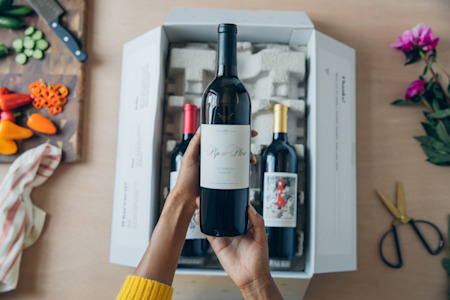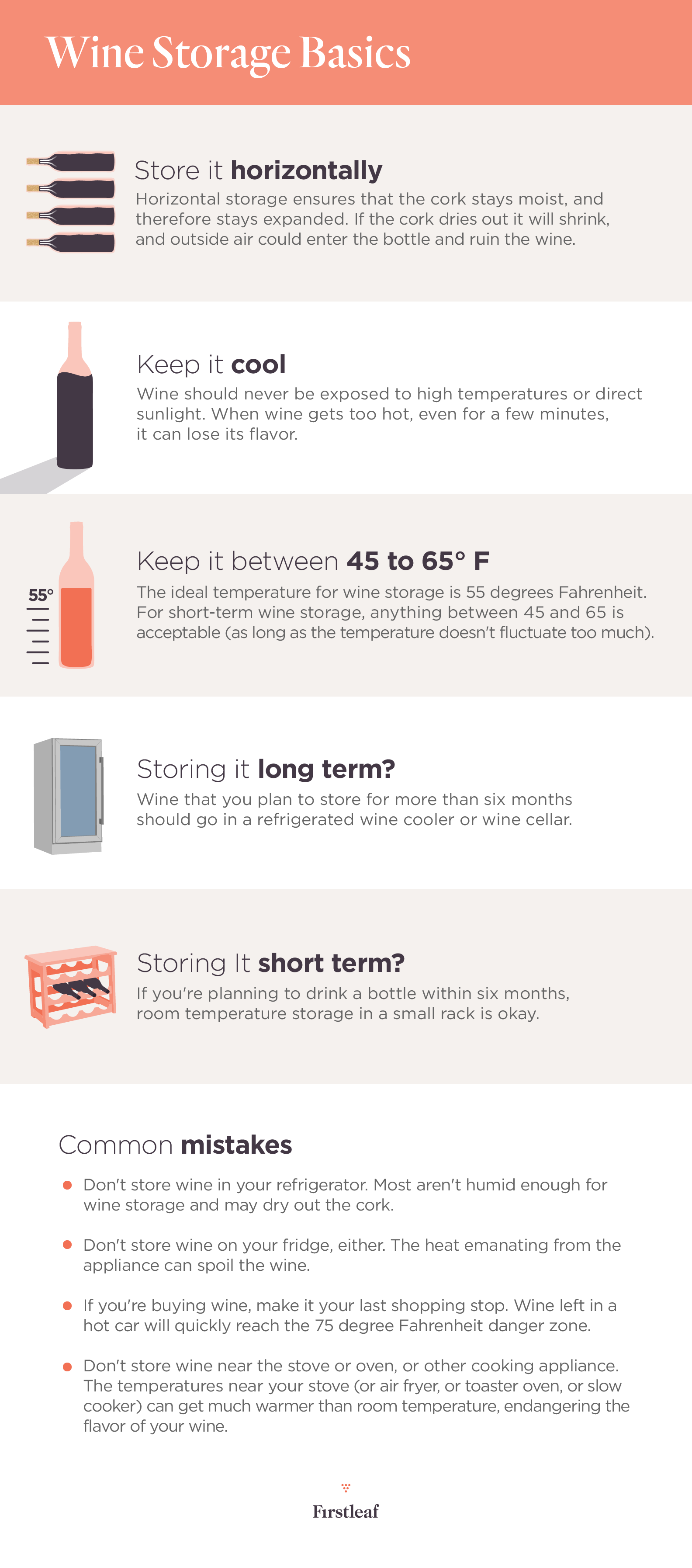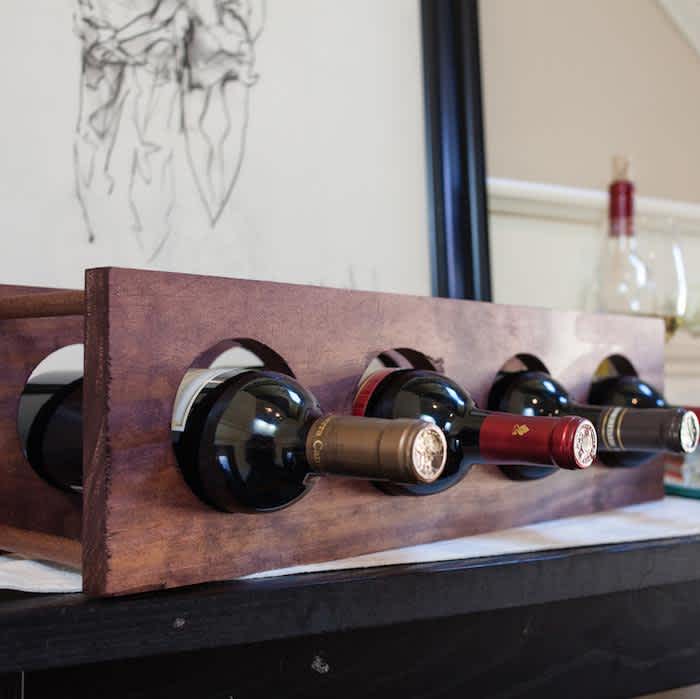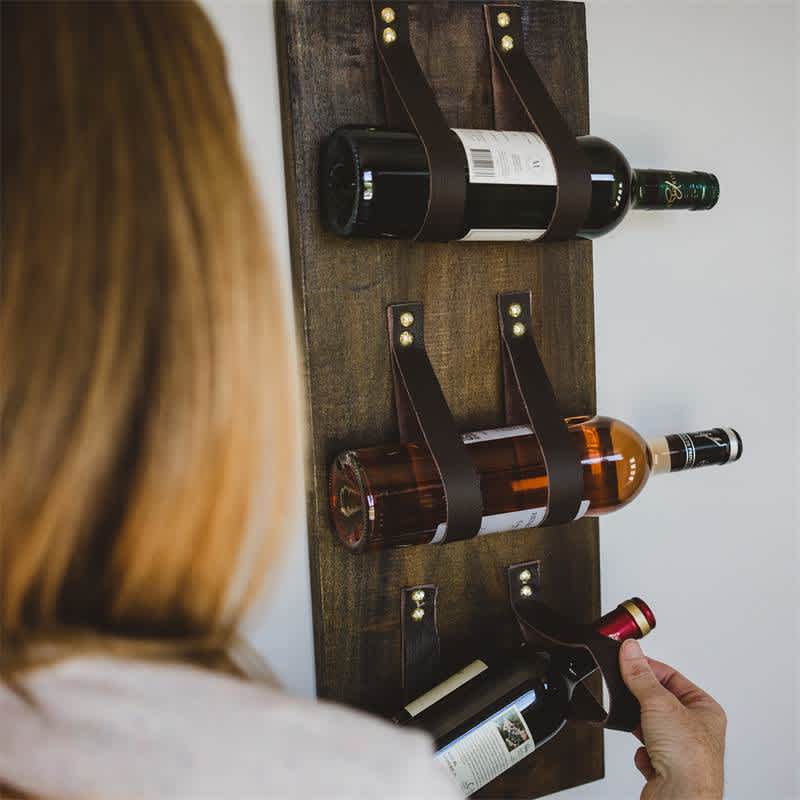How to Build a DIY Wine Cellar & More Storage Solutions
Key things to remember when storing wine, plus tips on how to create your own wine storage—from wine racks to a fully-outfitted DIY wine cellar.
A bottle of wine stored in your home is a gift waiting to be opened. You may be waiting for a special occasion, that perfect wine and food pairing, or a rainy weekend afternoon — but when that day finally comes, you want to be sure that the wine is drinkable.
The flavor of wine can be ruined by improper storage. Here's how to store your wine so you have the ideal drinking experience, every time.
IN THIS ARTICLE:
Want personalized wines?
Get your first box of wines for $44.95 + free shipping.

Wine Storage Basics
The basics of proper wine storage involve position, light, and temperature.
Wine with a cork must be stored horizontally. (Read about “corked” wine here.) Horizontal storage ensures that the cork stays moist, and therefore stays expanded. If the cork dries out, it will shrink, and outside air can enter the bottle and ruin the wine.
Wine should never be exposed to direct sunlight or high temperatures. When wine gets too hot, even for a few minutes, it will lose flavor.
What is the best temperature for wine storage? The ideal temperature for wine storage is 55 degrees Fahrenheit. For short-term wine storage, anything between 45 and 65 degrees is acceptable (as long as the temperature doesn't fluctuate too much).
Curious if wine goes bad after you open it? Read our article.
Wine that you plan on storing for months or years should go in a refrigerated wine cooler or wine cellar.
These rules apply to red wine, white wine, and sparkling wine. You can keep all three types in the same place, you don't need different storage temperatures — though each does have different serving temperatures.
What Are the Types of Wine Storage?
Wine storage options fall into three categories: wine refrigerators, wine racks, and wine cellars (that includes DIY wine cellars and custom wine cellars).
Wine Refrigerators
A wine refrigerator is the best choice for people who want foolproof wine storage and they take up just a small space in your kitchen. These specialty refrigerators are designed for wine with dimensions and shelving that match standard wine bottles. Some also have special slots for large or oddly-shaped wine bottles.
With a wine refrigerator, you simply plug it in, insert your wine, and close the glass door. As long as the power is on, your wine is being properly stored.
The drawback of a wine refrigerator is the cost. (And at Firstleaf, we’re all about saving you money.) While an entry-level wine fridge that stores 6 to 8 bottles will cost about $150, the more bottles you want to store, the higher the price — wine refrigerators that store 100 bottles go for $2,000 or more. You also have to pay for the electricity to keep the refrigerator running. Wine refrigerators are fairly efficient, but running one will add at least a few dollars to your monthly utility bill.
Wine Racks
A wine rack is an inexpensive DIY wine storage option, and a way to add some flair to your kitchen, dining room, basement or wherever you want to store wine.
Wine racks come in many interesting shapes, sizes, and styles from brushed metal industrial looks, to rustic wood pallet varieties. If you're crafty and have design ideas of your own, you can even make your own custom wine rack.
A wine rack should be used for wines you plan to drink soon. (Check out our article on how to decant wine.) Unless you keep your wine rack in a wine cellar, it's not a good option for long-term storage. The wine in your kitchen wine rack is subject to the temperatures in your kitchen -- on average, room temperature is 65 to 75 degrees (and hotter if you happen to be cooking). Exposure to temperatures this high is okay for a few weeks, but over the long run, it can turn your wine's flavors flat or sweet—and not in a good way. Your wine should be sweet because it was made to be that way, not because of faulty wine storage.
Wine Cellars
A wine cellar or closet may conjure images of a dungeon with stone walls, but a wine cellar can be any room or small space you choose to keep cool and dry enough to store wine.
Long-term storage of wine isn't just about maintaining the wine's flavor. It can also be about enhancing it. That's why wines from decades past are often much more expensive than last year's bottles. Chemical reactions during the aging process cause flavors to develop and change for the better, but that's only if the aging is done properly.
Typically, DIY wine cellars must be heavily insulated and outfitted with cooling systems (or a cooling unit) to keep the temperature low and relatively steady. Large swings in temperature can cause the flavor of your wine to change for the worse.
How to Build a DIY Wine Rack
A basic wine rack should allow your bottles to rest horizontally and should contain secure compartments for every wine bottle.
Circular Cuts Wine Rack
This DIY wooden wine rack from Craft Box Girls is a 4-bottle design that would be perfect for a kitchen counter or a dining room table.
The circular cuts are measured to make the wine easy to insert and also secure the wine bottles in case the rack is bumped. This isn't a difficult DIY project, but it does require specialized woodworking tools such as a miter saw and a hole cutter.
Leather Wine Rack
This wall-mounted wine rack from Fiskars is a 3-bottle design idea. The frame of the wine rack is wood, and the wine is secured with leather straps. Do you live in a small space? Storing the wine on your kitchen or dining room wall frees up countertop space!
The project is a good use for scrap or reclaimed wood, and doesn't require any power tools.
Copper Pipe and Leather Wine Rack
This contemporary DIY wine rack from A Bubbly Life features leather compartments within a copper frame. The copper tubing is inexpensive -- probably less than the bottles of wine you'll be storing on them.
This project does require a pipe cutter, or a miter saw if you have one.
Countertop Wine Rack
This classic restaurant-style wine rack by April Wilkerson uses intersecting wood pieces for a compact 8-bottle DIY wine rack.
This is a classic woodworking project that doesn't rely on metal fasteners. Every piece fits into invisible slits that are cut with a jigsaw or bandsaw.
Wine Rack Storage Cube
This large cube rack featured on Instructables Workshop is a good way to store a lot of wine bottles in one place. It's really two separate projects -- the exterior cube and the interlocking x-shaped piece of wood within it.
You'll need a Kreg Jig (a special tool that creates pocket holes) to connect the pieces in the cube section. Notches to connect the interlocking pieces for the x-section can be made with a jigsaw or bandsaw.
IKEA Wine Rack
If you'd rather leave the woodworking to the experts, Homedit has some ideas for turning prefabricated IKEA storage products into wine storage.
Narrow IKEA bookshelves are a decent fit for wine bottles, or you can subdivide storage cabinets with small pieces of wood to create wine-specific storage. IKEA also sells wine storage units as part of their kitchen systems.
How to Build a DIY Wine Cellar
Wine racks are meant to store bottles for a few weeks at room temperature. If you plan to store a special wine collection for months or years, you should protect your wine's flavor with your own home wine cellar. The wine cellar you build will need to maintain constant temperature, humidity, and darkness levels. On top of building in proper bottle racks and ensuring your wine cellar stays vibration free.

Sign up for the Club Today
Discover exceptional wines from all over the world all delivered to your doorstep. Sign up with Firstleaf Wine subscription and get wines that you'll love. Start now by taking our Wine Quiz!
Take Our QuizWhat Are the Ideal Wine Cellar Conditions?
A wine cellar should ensure the following conditions.
A consistent temperature, as close as possible to 55 degrees Fahrenheit
A humidity level of 50% to 70%
Dark and vibration-free storage
Horizontal bottle storage
Proper insulation
How to Choose a Location for Your Wine Cellar
The ideal location for a wine cellar is in a below-ground part of your structure where the ground will help regulate the temperature. If you don't have any below-ground space, you'll want to pick the room in your house that's easiest to keep cool and humid. It should also be a small space, isolated from exterior walls, and have as few windows as possible with proper insulation.
Remember that the larger the room, the more you'll have to spend on cooling units. Some people divide existing rooms into two or end up using a wine closet for wine storage.
Planning a Wine Cellar
Building your own DIY wine cellar is all about figuring out how to meet the ideal wine cellar conditions mentioned above. If you happen to live in a temperate climate in a home with a deep, windowless basement, you may just need to set up a few racks in the basement and make sure to keep the door shut. This would be called a "passive cooling" system. Nature does the work for you.
But the majority of us live in areas where the temperature rises above 75 degrees or gets below 45 degrees -- even in a basement if we have one. These extreme temperatures will damage wine.
In this case, you need wine cellar innovations known as an "active cooling" system. It's what most modern wine cellars have, and a key choice in building your wine cellar.
Wine Cooling Systems
Wine cooling systems are essentially air conditioners or cooling units designed for wine bottles instead of people. They regulate humidity as well as temperature. These units aren't cheap. They start at around $1,000 and go up from there, based on how large or small the space is that you are trying to keep cool.
There are self-contained wine cooling systems that vent to an outside room (similar to an air conditioning unit). But you can also buy units that connect with the ducts in your home, using the overall HVAC system to regulate the temperature and humidity in your wine cellar.
Framing a Wine Cellar
If you are framing out a wine cellar you can choose to use 2 by 6 wall studs rather than the traditional 2 by 4 studs. Using the wider wall studs creates more space for insulation in the walls.
Insulation and Vapor Barriers
Your wine cooling system will be much more effective if the walls of the DIY wine cellar are insulated properly. The cooler the ambient temperature, the less work the cooling system has to do.
But insulation also helps to protect the structural integrity of your home. Because your cellar shares walls with rooms that will be warmer, the spaces between these rooms -- within your walls -- can fill with condensation and eventually mold. Insulation, plus the extra step of a vapor barrier of polyurethane sheeting or closed-cell foam, can reduce the amount of moisture in the walls and in the air.
Finish for Walls and Flooring
Moisture buildup is the enemy of your DIY wine cellar, so be sure to use finishes on all surfaces. Unfinished concrete walls and floors, for example, are extremely porous. Talk with an expert at your local paint or hardware store about the most effective finishes for the surfaces in your cellar. Or need a wine expert? Talk to our Wine Concierge.
The All-Important Door
Your wine cellar can have the perfect insulation, be sealed against unwanted moisture, and have a several thousand-dollar wine cooling system humming away -- but if air or moisture leaks through the door, all your work is wasted.
The wine cellar should not have an ordinary door. Make sure to choose something thick that allows for weather-stripping to keep the cellar sealed as much as possible.
It's a good idea to investigate the cellar for airflow or air leaks after everything has been installed.
How to Fill Your Wine Rack or DIY Wine Cellar
You’ve got your wine rack, wine closet or DIY home wine cellar ready to go. You’re excited to host a wine tasting or start building your wine collection. But you’re not sure how to find new wines you’ll love at reasonable prices? That’s where Firstleaf comes in. Firstleaf’s wine club tailors world-class red wine, white wine, rosé wine and even sparkling wine to your taste. A monthly wine subscription service like Firstleaf gives you the convenience of having outstanding wines delivered to your home on your schedule. Professionals store the wine at proper temperatures until they ship it to you, ready to open and enjoy responsibly. You can drink your personalized wines right away or store them in your new wine rack, wine closet or home wine cellar!
IN THIS ARTICLE
Want personalized wines?
Get your first box of wines for $44.95 + free shipping.


WinePrint™ by Firstleaf
Are you looking to learn more about your wine preferences? Check out our Wine Print for an in-depth look at your personal tasting profile. Discover your favorite wines, varietals, regions, and tasting notes and get personalized recommendations wherever you are.
Learn More


